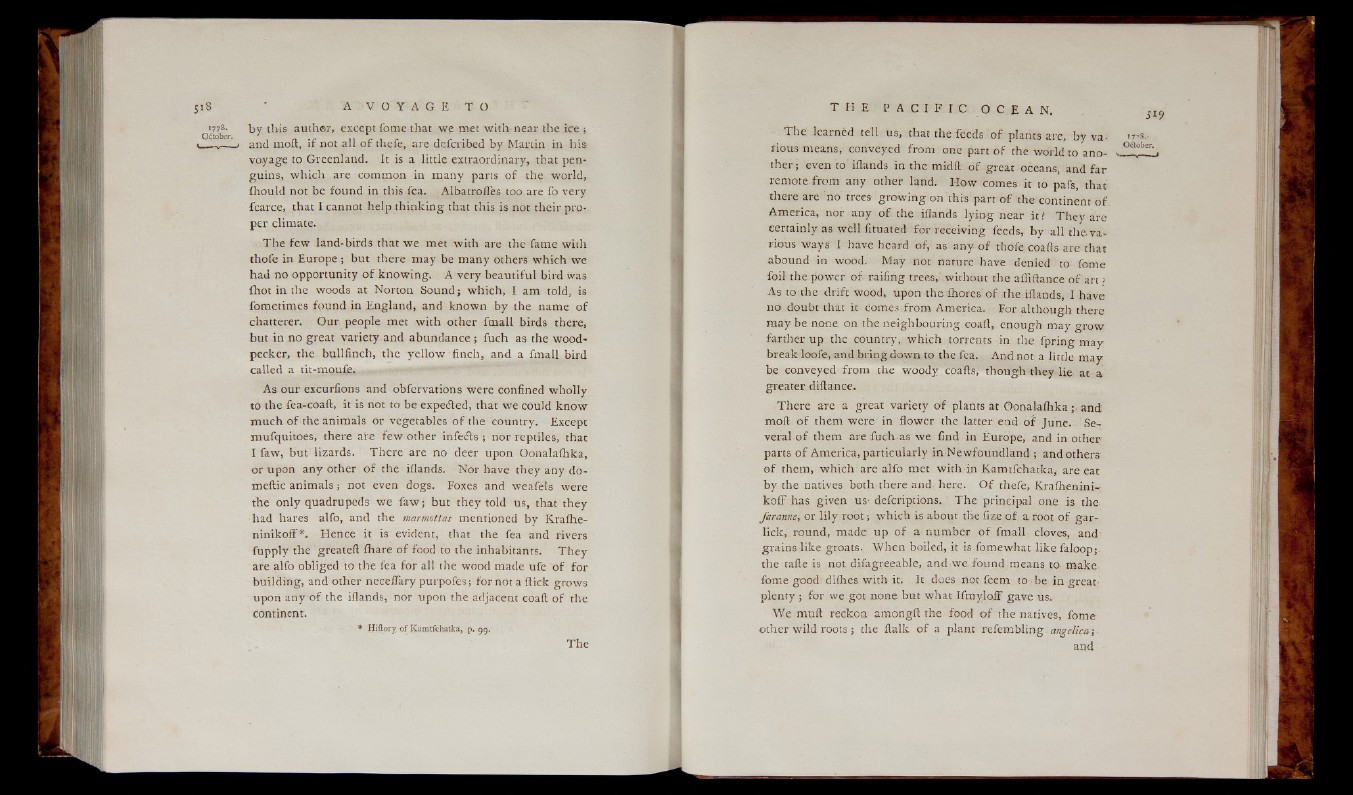
^1778. by this author, except fome that we met with near the ice ;
» and moil, i f not all o f thefe, are defcribed by Martin in his
voyage to Greenland. It is a little extraordinary, that penguins,
which are common in many parts o f the world,
iliould not be found in this fea. AlbatroiTes too are fo very
fcarce, that I cannot help thinking that this is not their proper
climate.
T he few land-birds that we met with are the fame with
thofe in Europe ; but there ma y be many others which we
had no opportunity o f knowing. A very beautiful bird was
fhot in the woods at Norton Sound; which, I am told, is
fometimes found in England, and known by the name o f
chatterer. Our people met with other fmall birds there,
but in no great variety and abundance ; fuch as the woodpecker,
the bullfinch, the y e llow finch, and a fmall bird
called a tu-mouje.
As our excurfions and obfervations were confined wholly
to the fea-coaft, it is not to be expedted, that we could know
much o f the animals or vegetables o f the country. Except
mufquitoes, there are few other infedts ; nor reptiles, that
I faw, but lizards. There are no deer upon Oonalafhka,
or upon any other o f the iflands. Nor have they any do-
meftic an im a ls ; not even dogs. Foxes and weafels were
the only quadrupeds we faw ; but they told us, that they
had hares alfo, and the marmottas mentioned by Kraihe-
ninikoff*. Hence it is evident, that the fea and rivers
fupply the greateft fiiare o f food to the inhabitants. T h e y
are alfo obliged to the fea for all the wood made ufe o f for
building, and other necefiary purpofes; for not a flick grows
upon any o f the iflands, nor upon the adjacent coaft o f the
continent.
* Hiftory o f Kamtfchatka, p. 99,
The learned tell us, that the feeds o f plants are, by va- ir’ S.-
fious means, conveyed from one part o f the world to ano- - oa°ber-.
ther; even to iflands in the midft o f great oceans, and fa r
remote from any other land. How comes it to pafs, that
there are no trees g rowin g chi this part o f the continent of.
America, nor any o f the iflands ly in g near it ? T h e y are
certainly as well fituated for receiving feeds, by all the v a rious
ways I have heard of, a6 any o f thofe coafts are that
abound in wood. May not nature have denied to fome
foil the power o f raifing trees, without the aififtance o f art?
As to the drift wood, upon the ihores'of the iflands, I have
110 doubt that it. comes from America. For although there
may be none on the neighbouring coaft, enough may grow
farther up the country, which torrents in the fpring may
break loofe, and bring down to the fea. And not a little may
be conveyed from the woody coafts, though they lie at a
greater diftanee.
There are a great variety o f plants at O o n a la ih k a a n d
moft o f them were in flower the latter end o f June. Several
o f them are fuch as we find in Europe, and in other
parts o f America, particularly in Newfoundland ; and others
o f them, which are alfo met with in Kamtfchatka, are eat
by the natives both there and here. O f thefe, Kraihenini-
k o ff has given us- defcriptions. The principal one is the
J'aranne, or lily ro o t; which is about the fize o f a root o f gar-
lick , round, made up o f a number o f fmall cloves, and
grains like groats. When boiled, it is fomewhat like faloop;
the tafte is not difagreeable, and-we found means to make
fome good difhes with it. It does not feem to be in great
plenty ; for we got none but what IfmyloiF gave us.
We muft reckon amongft the food o f the natives, fome
other wild ro ots; the ftalk o f a plant refembling angelica;
and